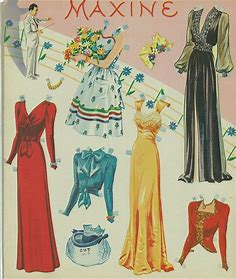The Timeless Charm of Paper Dolls: A Journey Through History, Craft, and Play

Paper dolls have enchanted generations with their simplicity, creativity, and charm. These cut-out figures and their interchangeable outfits have been a beloved pastime for centuries, offering endless possibilities for imaginative play. This blog post explores the fascinating history of paper dolls, their cultural significance, the joy of crafting and playing with them, and their evolution in the digital age.
A Brief History of Paper Dolls
Early Beginnings
The origins of paper dolls can be traced back to ancient civilizations. The earliest known paper dolls date to 800 AD in Japan, where elaborate paper figures were used in religious rituals. These figures were not toys but held significant cultural and spiritual value.
18th Century Europe
Paper dolls as toys began to emerge in 18th-century Europe. The first commercial paper dolls appeared in France and England around the mid-1700s. These dolls, often hand-painted and intricately detailed, were marketed to wealthy families and used for both play and educational purposes.
19th Century Popularity
The 19th century saw a boom in the popularity of paper dolls, particularly in the United States and Europe. Advances in printing technology allowed for mass production, making paper dolls more affordable and accessible. Companies like McLoughlin Brothers in the United States began producing paper dolls with a wide range of themes, from fashion and fairy tales to historical figures and everyday life.
20th Century Golden Age
The early to mid-20th century is considered the golden age of paper dolls. During this period, paper dolls were ubiquitous, found in magazines, newspapers, and as standalone sets. Iconic figures such as Shirley Temple and Marilyn Monroe had their paper doll counterparts, reflecting the era’s fascination with celebrities and Hollywood glamour.
The Cultural Significance of Paper Dolls
Educational Tool
Paper dolls have long been used as an educational tool, helping children develop fine motor skills, creativity, and an understanding of social and cultural norms. They often depicted historical figures, traditional costumes, and various professions, providing a fun way for children to learn about the world.
Fashion and Design
For many, paper dolls were an early introduction to fashion and design. They allowed children to experiment with different styles and trends, fostering an appreciation for aesthetics and clothing. Some of the most famous fashion designers, including Karl Lagerfeld and Vera Wang, credited their childhood play with paper dolls as an inspiration for their careers.
Social and Cultural Reflection
Paper dolls have often mirrored the social and cultural dynamics of their times. From the modest Victorian-era dolls to the bold and diverse representations of modern times, they reflect changing attitudes towards gender roles, fashion, and societal norms.
Crafting and Playing with Paper Dolls
Materials and Tools
Creating paper dolls is a delightful and accessible craft that requires minimal materials. Basic supplies include:
- Paper or Cardstock: Sturdy enough to hold up to repeated play.
- Scissors: For cutting out the dolls and their outfits.
- Coloring Tools: Crayons, colored pencils, markers, or paint for customizing.
- Adhesives: Glue or tape to attach stands or reinforce parts.
Designing Your Own
Designing and crafting your paper dolls can be an enjoyable and creative activity. Here’s a simple guide to get you started:
- Draw the Doll: Sketch a basic figure on paper or use a printable template.
- Create Outfits: Draw clothing items, ensuring they fit the doll’s proportions. Include tabs to attach the clothes to the doll.
- Color and Decorate: Use coloring tools to add details and personality to your dolls and outfits.
- Cut and Play: Carefully cut out the doll and its outfits, then enjoy hours of imaginative play.
Digital Paper Dolls
In the digital age, paper dolls have evolved to include digital versions. Websites and apps offer virtual paper dolls that can be dressed and customized with a click or tap. These digital dolls provide a modern twist on a classic pastime, appealing to tech-savvy children and adults.
The Enduring Appeal of Paper Dolls
Despite the advent of electronic toys and games, paper dolls continue to hold a special place in the hearts of many. Their enduring appeal lies in their simplicity, the joy of hands-on creation, and the limitless possibilities for imaginative play. Whether cherished as collectibles, used as educational tools, or enjoyed as a nostalgic craft, paper dolls remain a timeless and beloved form of entertainment.
Conclusion
Paper dolls have a rich history that spans cultures and centuries, reflecting the social, educational, and artistic values of their times. They offer a unique blend of creativity, play, and learning, making them a cherished part of childhood for generations. Whether you are a collector, a parent introducing them to your child, or an enthusiast enjoying a nostalgic craft, paper dolls continue to captivate and inspire with their timeless charm.

